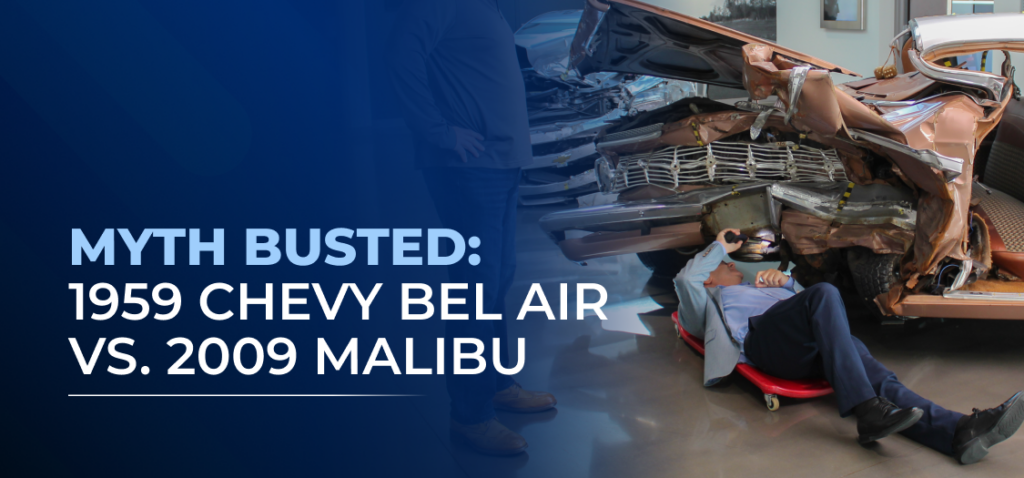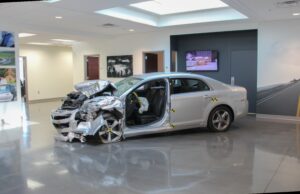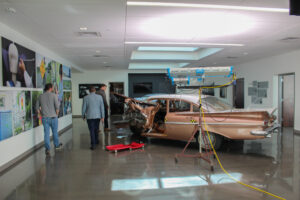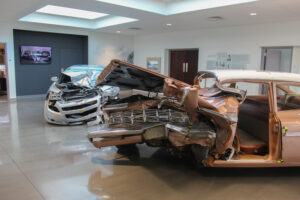Myth Busted: 1959 Chevy Bel Air vs. 2009 Malibu Crash Test

Recently, I had the opportunity to co-host a webinar at the Insurance Institute for Highway Safety’s (IIHS) Vehicle Research Center with Matt Moore, the Chief Insurance Operations Officer. During the session, we covered a variety of topics related to vehicle safety testing.

However, one exhibit in the lobby caught my attention: the 1959 Chevrolet Bel Air, famously involved in a crash test with a 2009 Chevrolet Malibu. This test, conducted in 2009 to mark IIHS’s 50th anniversary, sparked controversy and gave rise to conspiracy theories that continue to circulate online. The 2009 crash test video has become iconic. The sight of the classic Bel Air, a car many believed was built to withstand crashes due to its strong frame and steel body panels, crumpling so easily when it collided with the modern, unibody Malibu shocked many. For some, this test demonstrated just how far vehicle safety has come, while others dismissed it as a staged stunt to promote the superiority of modern cars. One of the most persistent responses to the test has been the accusation that the Bel Air was somehow “manipulated” to make it crumple more easily. These myths include claims that the 1959 car’s frame was weakened or cut before the crash, or that it was rusted and damaged in ways that made it unsafe.

With these ideas floating around, I knew I had to investigate. Armed with a flashlight and an auto creeper, I crawled under the car to see for myself whether there was any truth to these persistent myths.
The Truth About the 1959 Bel Air
What I found was unsurprising: the 1959 Bel Air showed no signs of structural rust or frame modification. I saw the remains of the Blue Flame 235ci straight-six sitting in the engine bay. But beyond the physical damage, I was surprised by how clean and well-maintained this base-model Bel Air was. It hadn’t been tampered with, and there was no evidence to suggest it had been modified for the crash test. In fact, the car was in such good condition that it seemed to have come straight from the factory, just as it would have in 1959.

Debunking the Myths
Despite my firsthand inspection, the myths continue to thrive online. Here are a few examples of comments I’ve seen on YouTube and other forums about the test:
- “The car might have looked mint on the outside, but all the orange dust thrown up during the crash suggests the chassis was quite rusty.
- “That’s a totally misleading test. Without an engine and transmission in it, of course, an empty shell would crumple. They probably cut the frame too, to sell us a feeling of false safety. What else are they manipulating?”
- “I read an article in a car magazine about this test. They claimed the ’59 had been ‘cut’ and weakened to dramatize the outcome.
While these comments show just how far the myths have spread, my inspection didn’t reveal any evidence supporting these theories. The car’s drivetrain remained intact, and the frame was solid and unaltered. The Bel Air simply did what many classic cars would do in a modern crash: it crumpled significantly, because its design wasn’t built to withstand the kinds of forces that modern vehicles are engineered to handle.
The Legacy of the 1959 Bel Air

The 1959 Chevrolet Bel Air’s role in this crash test has made it an accidental legend in the world of classic car enthusiasts and conspiracy theorists alike. But despite the myths that continue to circulate, the test remains a powerful reminder of how much progress has been made in vehicle safety.
IIHS’s crash tests are not meant to criticize classic cars. Rather, they highlight the advancements in vehicle design, safety features, and crash protection achieved over the past several decades. The Bel Air vs. Malibu test clearly demonstrates how far we’ve come—both in terms of vehicle safety engineering and our understanding of how cars protect us in collisions.
I often wonder if the previous owners of the Bel Air ever realized how their car would be used to teach future generations about car safety. Regardless, the Bel Air’s sacrifice in that 2009 test helped open many eyes to the importance of continuous improvement in vehicle safety. It also brought attention to the fact that no matter how persistent myths and conspiracy theories may be, they can’t change the facts.
Final Thoughts
In the end, while the myths about the Bel Air crash test may continue to persist, the truth is clear: the car was not altered, and it represented the safety standards of its time. As we continue to improve vehicle safety, it’s important to remember that progress is built on lessons learned from the past—no matter how dramatic the crash.
I hope that more people will see the actual evidence showing that the Bel Air’s drivetrain remained intact and that its frame was neither rusted nor tampered with. But even if the myths endure, one thing remains undeniable: vehicle safety has come a long way since 1959.
